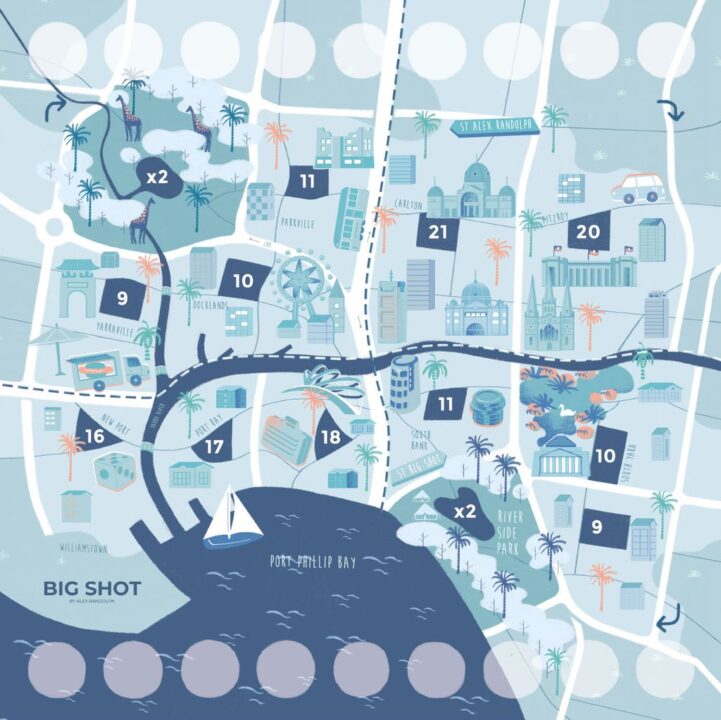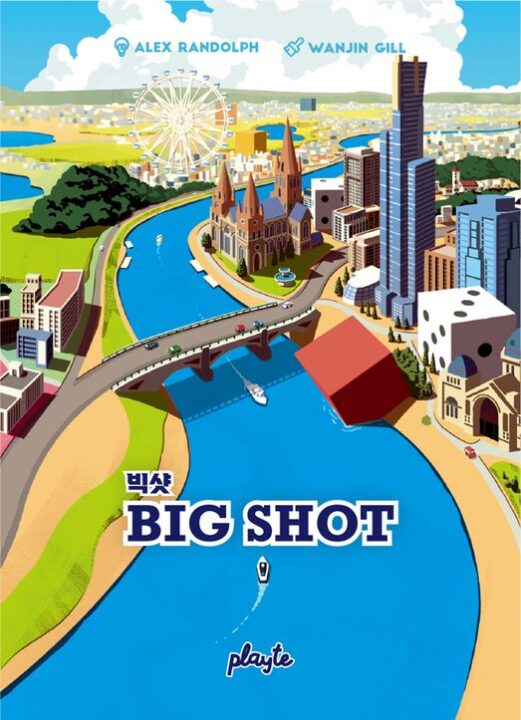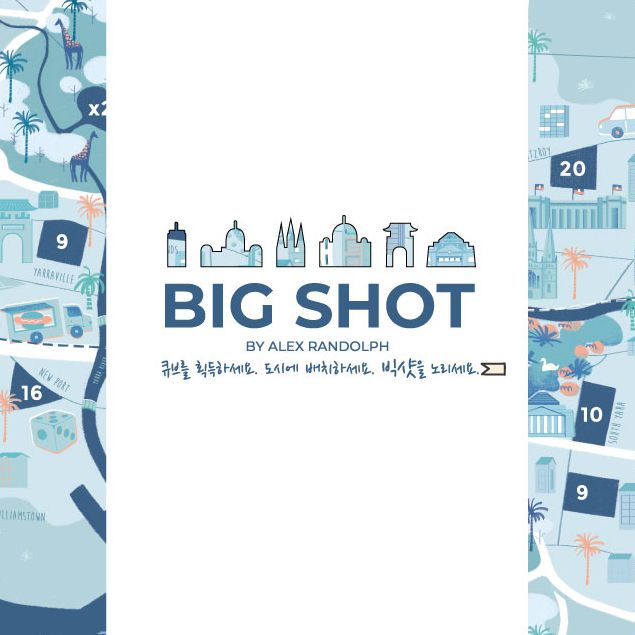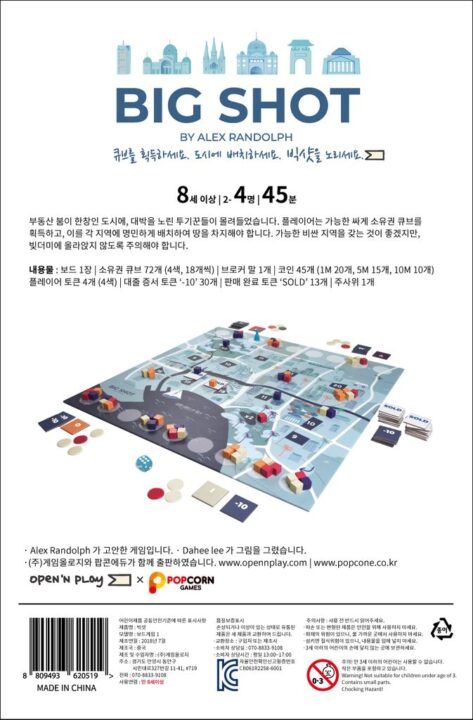Alright, folks—strap in, because it’s time for my review of Big Shot! This game landed on my table after a heated debate between friends about who could bluff the best. I’ll spill all the beans: the drama, the chaos, the chunky cubes, and plenty of laughs (plus the odd grumble about luck). If you’ve ever wanted a game that mixes auctions, area control, and cunning negotiation, you might want to see how this one stacks up. But does it actually play fair, or does luck crash the party? Let’s find out together!
How It Plays
Setting up
First, lay out the board in the center. Give each player colored cubes (your markers of doom!), and some starting money. Shuffle the district cards. Place them face down as a draw pile, and hand everyone a player screen for their secret cubes and cash. Now, put the coffee on because you’re about to start arguing for an hour straight.
Gameplay
Each round, flip a district card. Players take turns bidding on it. Everyone throws money around and forms secret alliances (or yells at their brother). The winner decides where to place their cubes in the district. But watch out! Others can also sneak cubes in if they pay the right price. Some rounds get spicy when everyone gangs up on the leader. The game is mostly about bluffing, making deals, and sometimes just annoying your friends for fun.
Winning the game
Once all districts are claimed, it’s time to see who rules the board. Count who controls the most districts. Majority in a district wins it. The player with the most districts at the end is the Big Shot—the ultimate tycoon. Gloating is optional, but highly encouraged.
Want to know more? Read our extensive strategy guide for Big Shot.
Gameplay Mechanics and Player Interaction in Big Shot
Alright, let’s talk about what actually happens when you gather your mates and slap Big Shot on the table. This is not just a case of chucking some colourful cubes about and seeing what happens. Big Shot brings in a tasty mix of area control and sneaky auction mechanics that get everyone involved, grumbling, wheeling, and dealing. My friend Rachel once offered to do my dishes for a week if I let her win an auction – pure chaos. (She did not win the auction nor do the dishes… typical.)
Each round opens with players bidding on neighbourhood tiles, trying to snap up control of key spots. What makes Big Shot sing is how everyone can invest in each other’s neighbourhoods. You might have the winning bid, but don’t get too comfy: rivals can and will boost your properties, usually so they can stab you in the back later. Every decision builds tension. Sometimes, you bid high so others waste their cash; other times, you fold and save up for a bigger move, like a croc lurking in the river.
The interaction here is as hot as fresh pizza. You must negotiate, bluff, and at times, beg. Every round, you’ll watch the same alliances form and shatter faster than my New Year’s resolutions. Every auction is a little drama, and every deal leads to wild accusations (always unfounded, obviously). There are no passengers in Big Shot. Expect to be called out for sneaky plays or praised for clever schemes, right up to the last turn. No one can snooze through the action—trust me, I tried and nearly missed a major coup.
All this hubbub begs the question: is Big Shot a thinker’s game, or does luck rule the day? Let’s shuffle over to that spicy debate next!

Luck or Brains: Where Does Big Shot Land?
When it comes to balancing luck and strategy, Big Shot walks a bit of a wobbly line. I brought this out with my group and, just like me trying to walk after too much soda, things got unpredictable pretty quick. In Big Shot, you cough up cash to bid for spots on the board, and that feels strategic. Deciding when to pounce and when to fold? Pure player genius (or so I tell myself when I win).
But here’s where the luck monster sneaks into the party. The cubes you get to place are drawn at random. Sometimes you get exactly the color you want and it feels like destiny. Sometimes you draw the color no one wants and it feels like the designer is laughing at you. I watched my friend Maria, who usually wins everything, get totally hosed by bad cube draws. She went from big shot to big not. That randomness can make or break a round, so even the most brilliant plans can get totally wrecked.
So, does Big Shot reward clever strategy? Yes—sometimes. But does luck have an annoying way of jumping in and flipping the table? Also yes. This isn’t a game for people who want total control, but if you enjoy a little chaos, it works. I wish it tilted more toward strategy, but it’s not the worst offender I’ve seen. Next, I’ll spill the beans on the bits: Big Shot’s components and why its art either charmed or confused my cat.

Big Shot: Components and Tabletop Eye Candy
Let’s talk goodies in the box! When I opened Big Shot, I got that nice whiff of fresh cardboard and plastic. That smell alone deserves five stars (but sadly, this isn’t a candle review). The board is bright and bold, with chunky colors that make it look like a property map drawn by a not-so-great city planner. I mean that in the best way. Each neighborhood stands out, which really helps keep track of where you’re clinging to hope and where you’re tanking faster than my uncle’s crypto investments.
The money tokens are straight-up classic. Nothing too fancy — you won’t fool anyone into thinking you’re rich, but you also won’t get paper cuts like that time I played Monopoly too seriously. The cubes for marking influence are big and chunky. I have clumsy hands and I dropped these cubes multiple times. My dog probably thought it was snack time. But the chunkiness means you’re not searching for them in the carpet like lost earrings.
As for the overall visual appeal, Big Shot lays out nicely on the table. Friends walking past my gaming table actually stopped and said, “What’s that?” This is good! The game screams, “Come mess up your friendships!” in the most inviting way possible. There’s no confusing iconography or tiny print. If you can see, you can play.
So, the components do their job: They’re sturdy, they pop on the table, and they survive the occasional caffeine spill. Up next, I’ll tell you if you’ll actually want to play Big Shot again, and with how many victims… I mean, friends!

Is Big Shot Worth Playing Again? Replay Value & Best Player Counts
Alright, time to talk about how often you’ll actually want to play Big Shot, and who should sit at the table. Honestly, replay value is one of the sneakiest traps in board games. You know that feeling where a game is fun the first night, but then collects dust like my New Year’s resolutions? Well, Big Shot dodges that trap pretty well.
Each game feels a little different thanks to those wild auctions and the shifting ownership of city blocks. You never quite know who’s about to turn on you or snatch your lead with a surprise bid. It keeps you on your toes, and my buddies and I rarely had the same winner twice in a row. If you enjoy bluffing, plotting, and trying to remember who owes you a favor from last round, Big Shot keeps serving up new drama every time.
Now, player count. The box says 2-5, but hear me out: don’t bother with two. I tried, and it felt like arm-wrestling your own hand. With three or more, things really come alive! Four is the sweet spot, in my opinion. There’s just enough chaos for things to get spicy, but not so many players that you lose track of who’s plotting what. Five works too, but get ready for some lively arguments and probably a longer game. Still, more laughs, more schemes. It’s a win.
So, do I recommend Big Shot? If you like your games full of sneaky deals and can forgive a little chaos, absolutely. It’s like Monopoly, but your friendships might actually survive.

Conclusion
So that wraps up my review of Big Shot! It’s a loud, bouncy game where bidding war meets area control and egos get bruised almost as much as wallets. I had a blast with four players, laughing and yelling and trying to outwit everyone in the room. The chunky cubes, the colorful board, and the frantic auctions kept us all on our toes. But it’s not all roses—if you hate randomness or two-hour feuds over who controls a tiny yellow square, you should steer clear. And with lower player counts, it just fizzles out. If you like games that mix some luck with plenty of scheming and don’t mind the chaos, Big Shot makes for a great night. Just keep your poker face ready and your friends close… but not too close. Thanks for reading!

